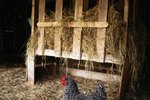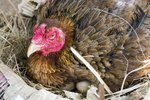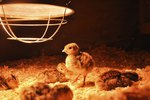
Raising ducklings can be a fun adventure, but if you aren’t careful, you can lose the delicate babies to cold. Therefore it’s necessary to provide ducklings with heat for the proper amount of time, usually between two and six weeks, depending on the weather and how quickly they develop feathers. Though heat lamps are usually necessary for no more than a few weeks, it is important to reduce the amount of heat you provide gradually and pay attention to the weather.
Preparing Pens
Baby ducks must be separated from other or older birds during their brood period, or the time they require the heat that simulates a mother’s body. Place them in a draft-free area on top of at least 4 inches of litter-like pine shavings or straw. Hang a heat lamp above their pen about 18 inches above the bedding. One heat lamp can provide enough warmth for about 35 ducklings, so if you have more than that, you’ll probably need to set up a second heat source. Set the lamp to 90 degrees.
Adjusting Heat
After you get the lamp set up, watch the ducks to see how they react to their new environment. If they are noisy and all huddling under the lamp, that means it is too cold. You should either turn the lamp up, or move it down. If they are pushed to the sides to avoid the lamp, or if they are panting, it is too hot or hanging too low. Adjust the height and temperature until your ducks are moving freely, some eating, some sleeping at all times.
Reducing Heat
Ducks do not need extra heat after they develop feathers. Generally you start the heat lamp at 90 degrees and reduce the temperature by 5 or 10 degrees each week until you reach 70 degrees. If they do not seem to need heat, demonstrated by crowding away from it, you can get rid of it. In cool weather, you’ll want to reduce the heat more slowly, whereas in warm weather you’ll reduce it more quickly, based on the ducklings’ actions.
Pasturing Ducks
Once ducks are fully feathered, they can stay outside all the time. If you begin introducing them to the outdoors before their feathers have come in, be aware that they may get cold and should therefore not spend all day outside. Let them go out for short periods at first, then increase the amount of time they spend outside during the day. After they are fully feathered, you may move them to an outdoor enclosure, but protect them from predators.
References
Photo Credits
-
Jupiterimages/Photos.com/Getty Images
Writer Bio
Sarah Moore has been a writer, editor and blogger since 2006. She holds a master's degree in journalism.




